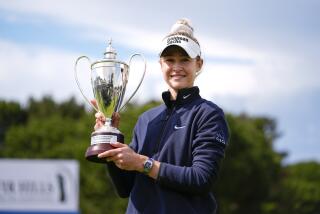A Star From the U.S. Could Make a Big Difference
- Share via
Annika Sorenstam lost the championship by a shot to Se Ri Pak and the Swede was smiling. Sometimes getting beat is better than winning by five shots. Sometimes playing 18 holes when every stroke matters is more fun than coasting. Sometimes having to go for the green with your second shot on the par-five 17th is more fun than playing an exhibition for the final three holes.
While clothes and smiles and good hair might make the woman, according to the new LPGA game plan for improving the visibility of professional women’s golf, what fundamentally helps is good competition. Lots of it. The more competitors the better.
It was a good day Sunday at El Caballero Country Club in Tarzana. From the first drive to the last putt, Pak, 24, from South Korea, and Sorenstam, 31, fought hard and stayed close in the final round of the Office Depot Championship Hosted by Amy Alcott.
There were lead changes and well-struck putts, iron shots hit with spin and nerve, controversial decisions, rimmed-out putts, nerve-testing saves from the traps and rough, some bogeys, some birdies and lots of fun.
What would have made this a great day is if there had been more challengers for Pak and Sorenstam, maybe even an American or two.
Laura Diaz, 26, a Wake Forest grad and Amelia Island, Fla., resident, played in the final group with Pak and Sorenstam. She was there, in her light red shirt and blue pants. “What a pretty girl,” a man said. “Who is she?”
She was the one always three or four shots behind, never quite able to meet the challenge, never quite up to the task of making this final round a three-way battle.
“Yes,” Pak said, “it would be good for the tour” if an American were near the top.
For the last two years, Sorenstam and Australia’s Karrie Webb have dominated. Pak has joined the battle this year.
But a tour played mostly in the United States, relying largely on U.S. television and sponsorship money, needs U.S. stars. More than friendly, nice-looking, fan-friendly athletes, the LPGA needs Americans challenging for the top of the leaderboard.
Women’s tennis was a dead zone as far as U.S. fans and media were concerned those few years when Steffi Graf, then Martina Hingis, seemed to win everything in sight. TV ratings fell, attendance plummeted, the WTA Tour lost major sponsors. Then along came Venus and Serena Williams. Lindsay Davenport began winning. Jennifer Capriati reappeared, and now women’s tennis is hot. Women’s golf needs Williams sisters, a Capriati and Davenport of its own.
Fans stood six and seven deep around the last few greens for Sunday’s final round. You could hear Korean and Swedish being spoken, Spanish too. There were some Aussies who had hoped Webb might contend. Pak said she felt almost at home with all the Korean fans who had supported her all week.
But when the tour leaves a multicultural place like Los Angeles, and when the sport looks for TV viewers from around the country to tune in, too many tune out when they see a leaderboard filled with Swedes, Koreans, Brits, Aussies and Canadians. Only five of the top 15 on the LPGA money list were born in the United States. Diaz is No. 2 Cristie Kerr is No. 5, Juli Inkster No. 8, Rosie Jones No. 9 and Heather Bowie No. 15.
“In many ways it would be good for the game,” Sorenstam said, “if there were more Americans near the top. But there are some young American players coming up also.”
Besides the 26-year-old Diaz, Kerr is 24, Inkster 41, Jones 42 and Bowie 27. This is not a group of youngsters on the rise. Pak is 24 and has already won three majors. She is a young player on the rise.
That said, what happened on the course Sunday was enthralling. Jamie Rose, an 11-year-old from Reseda who had pestered her father, Ed, to bring her to the tournament Sunday, said she could hardly wait to learn how to play golf. “I want to be like Se Ri,” Jamie said. “This is a cool game.”
Said Sorenstam: “I had a great time today. I was standing there on 17 and I have 165 yards to the pin with water on the left and it was then that I told my caddie that this is why we are here. I enjoy playing with Se Ri. I felt like this was a major with the crowd that was out there.”
Pak had come to the par-five 17th with a three-shot lead. She left one stroke ahead of Sorenstam. Because she was behind, Sorenstam had to be bold. She went for the green with her second shot, had a makable eagle putt and left with a birdie.
Because she was ahead, Pak played it safe. She thought. Pak laid up with her second shot, had 89 yards to the pin and hit the ball 119. She had a tricky chip, left it short, made bogey and slammed her bag with her hand. The crowd ran up the 18th fairway, jostling for position to watch the leaders play the final hole, a par-four with five bunkers around the green.
What they saw while they were standing on tiptoes was Sorenstam snaking a twisting, 30-foot birdie putt within breathing distance of the hole and an exuberant Pak almost making her 20-footer for birdie. Each made par, and they embraced as the crowd jumped up and down and cheered.
Diaz finished out her par alone and unnoticed. Third place, four shots from the lead, that was a nice week for Diaz. Nice but not great. Great would have been better. For everybody.
*
Diane Pucin can be reached at [email protected].
More to Read
Go beyond the scoreboard
Get the latest on L.A.'s teams in the daily Sports Report newsletter.
You may occasionally receive promotional content from the Los Angeles Times.










